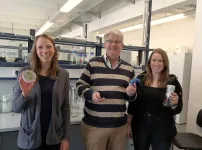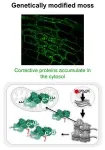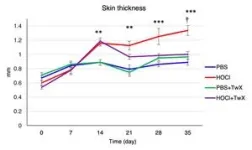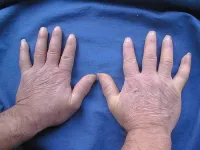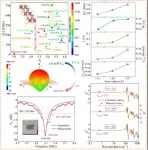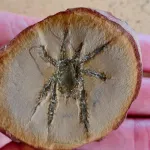(Press-News.org) Plants have special corrective molecules at their disposal that can make retrospective modifications to copies of genes. However, it would appear that these “Tipp-Ex proteins” do not have permission to work in all areas of the cell, only being used in chloroplasts and mitochondria. A study by the University of Bonn has now explained why this is the case. It suggests that the correction mechanism would otherwise modify copies that have nothing wrong with them, with fatal consequences for the cell. The findings have now been published in “The Plant Journal.”
Plant cells possess a whole host of specialized structures known as organelles, of which two particularly important ones are the chloroplasts and mitochondria. The former use light energy to convert carbon dioxide and water into oxygen and sugar, while the latter do more or less the same thing in reverse: they “burn” sugar and other compounds to generate the energy needed for numerous cellular processes.
The two organelles are unique in that they have their own genes. This genetic material works like sets of assembly instructions for key molecules that the organelles require for their work. If a chloroplast needs to make a certain protein, for instance, it first orders a copy of the relevant assembly instructions that it can then use to produce the protein.
Genes from chloroplasts and mitochondria often defective
“However, the genes in chloroplasts and mitochondria often contain defects,” explains Elena Lesch, a doctoral student at the University of Bonn’s Institute for Cellular and Molecular Botany. “So the copies have to be corrected, otherwise the proteins assembled based on their instructions won’t work.” For this, plants use a kind of Tipp-Ex—special molecules that belong to the group of pentatricopeptide repeat (PPR) proteins.
Plants have at least a dozen and, in some cases, as many as several thousand of these special PPR proteins, each one of which corrects highly specific defects. It is as if every word in a newspaper had its own sub-editor. Rather than being made in the organelles in which they are used, however, the PPR proteins are manufactured outside of the organelles, within the cytosol.
The cytosol is also packed full of gene copies, although these come from the cell’s nucleus, where most of the many thousands of the plant’s genes are stored. By contrast, mitochondria and chloroplasts only contain a few dozen genes each. The “Tipp-Ex proteins” could theoretically correct the copies inside the cytosol too. “But they don’t,” Lesch says. “They only do their work in the organelles, and we wanted to know why.”
Swamping the transportation mechanism into the organelles
One reason might be that the “molecular sub-editors” are simply moved too quickly from the cytosol into the organelles. To investigate this possibility, the researchers fitted a kind of molecular switch to PPR genes inside some of the moss Physcomitrium. This enabled them to make the cells produce very large quantities of PPR proteins virtually at the touch of a button. “We were able to demonstrate that this swamps the transportation mechanism,” reveals Lesch’s colleague Mirjam Thielen, who conducted many of the experiments. “It caused a pile-up of PPR proteins in the cytosol.”
Once they had arrived in the cytosol, they began to modify copies from the nucleus. “We analyzed the changes they made and saw that the proteins had modified a great many sets of assembly instructions that would actually have been correct,” Lesch says. “Incorrect interventions like these are counterproductive, of course, because they can put protein functions at risk.” But why should this be happening in the first place? As well as detecting defects, the PPR proteins also bind to what are known as off-target sequences, areas that may look like a defective sequence but are actually perfectly fine. “With copies of tens of thousands of genes jostling for space inside the cytosol, the risk of these off-target sequences being corrected incorrectly would be high,” Lesch notes.
Production of “Tipp-Ex” molecules subject to strict regulation
To prevent this, plants generally only ever make relatively low quantities of PPR proteins, which are then transported straight into the organelles before the molecular “Tipp-Ex” in the cytosol can do any harm. Because the number of genes—and thus how many copies of them there are—inside the chloroplasts and mitochondria is manageable, no such miscorrections tend to occur there.
The study is supplying new insights into how these corrective proteins identify their targets. In the future, therefore, it may be possible to use the findings to make highly targeted modifications to specific copies of genes inside mitochondria and chloroplasts and to investigate the effect of such modifications. Given the important roles that these organelles play in plants’ energy metabolism, this also opens up scope for some interesting practical applications.
Funding
The work was funded by the German Research Foundation (DFG).
END
Plants restrict use of “Tipp-Ex proteins”
University of Bonn study shows that molecules that modify copies of genes are only permitted in certain cell organelles
2024-05-17
ELSE PRESS RELEASES FROM THIS DATE:
New AI tool to help beat brain tumors
2024-05-17
A new AI tool to more quickly and accurately classify brain tumours has been developed by researchers at The Australian National University (ANU).
According to Dr Danh-Tai Hoang, precision in diagnosing and categorising tumours is crucial for effective patient treatment.
“The current gold standard for identifying different kinds of brain tumours is DNA methylation-based profiling,” Dr Hoang said.
“DNA methylation acts like a switch to control gene activity, and ...
Antioxidant Dietary Supplement “Twendee X®” can help counter systemic sclerosis
2024-05-17
Autoimmune diseases occur when the body’s immune system attacks healthy cells instead of protecting them. Systemic sclerosis (SSc) is one such autoimmune condition characterized by faulty circulatory and immune systems, leading to the occurrence of fibrosis (hardening and scarring of healthy tissue) of the skin and internal organs. SSc is known to affect patients throughout their lives, thereby, impairing their quality of life. Although precise mechanisms underlying SSc development and progression are not clearly understood, a complex interplay of immune, hormonal, environmental, and genetic factors is often implicated.
Moreover, ...
Low-permittivity LiLn(PO3)4 (Ln = La, Sm, Eu) dielectric ceramics for microwave/millimeter-wave communication
2024-05-17
Microwave dielectric ceramics are the cornerstone of wireless communication devices, widely utilized in mobile communications, satellite radar, GPS, Bluetooth, and WLAN applications. Components made from these ceramic materials, such as filters, resonators, and dielectric antennas, are extensively used in wireless communication networks. As wireless communication frequencies extend into higher bands, signal delay issues become increasingly prominent. Low dielectric constants (εr) can reduce electromagnetic coupling effects, effectively minimizing signal delays. Consequently, developing new ceramic materials with ...
Online dashboard to help save children from dangerous diarrheal diseases
2024-05-17
University of Virginia researchers are developing a flexible online tool for navigating information used in the fight to save children from deadly diarrheal diseases by identifying transmission hotspots and accelerating the deployment of treatments and new vaccines.
Diarrhea not only kills hundreds of thousands of children around the world every year, it contributes to malnutrition that can prevent kids from growing and developing to their full potential both physically and mentally, trapping them in poverty. While significant progress has been made against ...
Anti-diabetic treatment associated with reduced risk of developing blood cancer
2024-05-17
(WASHINGTON, May 17, 2024) – People who use metformin are less likely to develop a myeloproliferative neoplasm (MPN) over time, indicating that the treatment may help prevent the development of certain types of cancers, according to a study published in Blood Advances.
Metformin is a therapy used to treat high blood sugar in people with type 2 diabetes that increases the effect of insulin, reduces how much glucose is released from the liver and helps the body absorb glucose. A meta-analysis of previous studies connected the therapy with ...
Pickleball courts in a legal pickle #ASA186
2024-05-17
OTTAWA, Ontario, May 17, 2024 – Pickleball Legal Consultant is a job title that likely did not exist a decade ago, but as pickleball courts infiltrate neighborhoods to satiate an appetite for a sport whose namesake is a snack, communities take issue with the resulting influx of noise. Now homeowners’ associations and city councils face litigation by those whose lives are disrupted by pickleball’s din.
Charles Leahy, an attorney, retired mechanical engineer, and former HOA board member became ...
Ancient arachnid from coal forests of America stands out for its spiny legs
2024-05-17
LAWRENCE — More than 300 million years ago, all sorts of arachnids crawled around the Carboniferous coal forests of North America and Europe. These included familiar ones we’d recognize, such as spiders, harvestmen and scorpions — as well exotic animals that now occur in warmer regions like whip spiders and whip scorpions.
But there were also quite bizarre arachnids in these habitats belonging to now extinct groups. Even among these stranger species now lost to time, one might have stood out for its up-armored legs.
The ancient critter recently was described in a new paper published ...
Model disgorgement: the key to fixing AI bias and copyright infringement?
2024-05-17
By Ian Scheffler
By now, the challenges posed by generative AI are no secret. Models like OpenAI’s ChatGPT, Anthropic’s Claude and Meta’s Llama have been known to “hallucinate,” inventing potentially misleading responses, as well as divulge sensitive information, like copyrighted materials.
One potential solution to some of these issues is “model disgorgement,” a set of techniques that force models to purge themselves of content that leads to copyright infringement or biased responses.
In ...
Researchers develop “game-changing” blood test for stroke detection
2024-05-17
Stroke is the leading cause of disability worldwide and the second leading cause of death, but the right early intervention can prevent severe consequences. A new study led by investigators from Brigham and Women’s Hospital, a founding member of the Mass General Brigham healthcare system, and collaborators developed a new test by combining blood-based biomarkers with a clinical score to identify patients experiencing large vessel occlusion (LVO) stroke with high accuracy. Their results are published in the journal Stroke: Vascular and Interventional Neurology.
“We have developed a game-changing, accessible tool that could help ensure that more people suffering from ...
New guideline: Barrett’s esophagus can precede esophageal cancer, but not all patients need a procedure to remove abnormal cells
2024-05-17
Bethesda, MD (May 17, 2024) — The American Gastroenterological Association’s (AGA) new evidence-based Clinical Practice Guideline on Endoscopic Eradication Therapy of Barrett's Esophagus and Related Neoplasia, published today in Gastroenterology, establishes updated guidance for Barrett’s esophagus patients.
A precursor to esophageal cancer, Barrett’s esophagus is a condition in which the cells in the esophagus have been replaced with non-cancerous abnormal cells. These cells can progress to a condition called dysplasia, which may in turn become cancer. Dysplasia is considered low-grade or ...
LAST 30 PRESS RELEASES:
Can community awareness campaigns in low-resource areas improve early diagnosis of colorectal cancer?
Stardust study resets how life’s atoms spread through space
Practical education: Clinical scenario-based program development
The impact of family dynamics on eating behaviour – how going home for Christmas can change how you eat
Tracing the quick synthesis of an industrially important catalyst
New software sheds light on cancer’s hidden genetic networks
UT Health San Antonio awarded $3 million in CPRIT grants to bolster cancer research and prevention efforts in South Texas
Third symposium spotlights global challenge of new contaminants in China’s fight against pollution
From straw to soil harmony: International team reveals how biochar supercharges carbon-smart farming
Myeloma: How AI is redrawing the map of cancer care
Manhattan E. Charurat, Ph.D., MHS invested as the Homer and Martha Gudelsky Distinguished Professor in Medicine at the University of Maryland School of Medicine
Insilico Medicine’s Pharma.AI Q4 Winter Launch Recap: Revolutionizing drug discovery with cutting-edge AI innovations, accelerating the path to pharmaceutical superintelligence
Nanoplastics have diet-dependent impacts on digestive system health
Brain neuron death occurs throughout life and increases with age, a natural human protein drug may halt neuron death in Alzheimer’s disease
SPIE and CLP announce the recipients of the 2025 Advanced Photonics Young Innovator Award
Lessons from the Caldor Fire’s Christmas Valley ‘Miracle’
Ant societies rose by trading individual protection for collective power
Research reveals how ancient viral DNA shapes early embryonic development
A molecular gatekeeper that controls protein synthesis
New ‘cloaking device’ concept to shield sensitive tech from magnetic fields
Researchers show impact of mountain building and climate change on alpine biodiversity
Study models the transition from Neanderthals to modern humans in Europe
University of Phoenix College of Doctoral Studies releases white paper on AI-driven skilling to reduce burnout and restore worker autonomy
AIs fail at the game of visual “telephone”
The levers for a sustainable food system
Potential changes in US homelessness by ending federal support for housing first programs
Vulnerability of large language models to prompt injection when providing medical advice
Researchers develop new system for high-energy-density, long-life, multi-electron transfer bromine-based flow batteries
Ending federal support for housing first programs could increase U.S. homelessness by 5% in one year, new JAMA study finds
New research uncovers molecular ‘safety switch’ shielding cancers from immune attack
[Press-News.org] Plants restrict use of “Tipp-Ex proteins”University of Bonn study shows that molecules that modify copies of genes are only permitted in certain cell organelles
